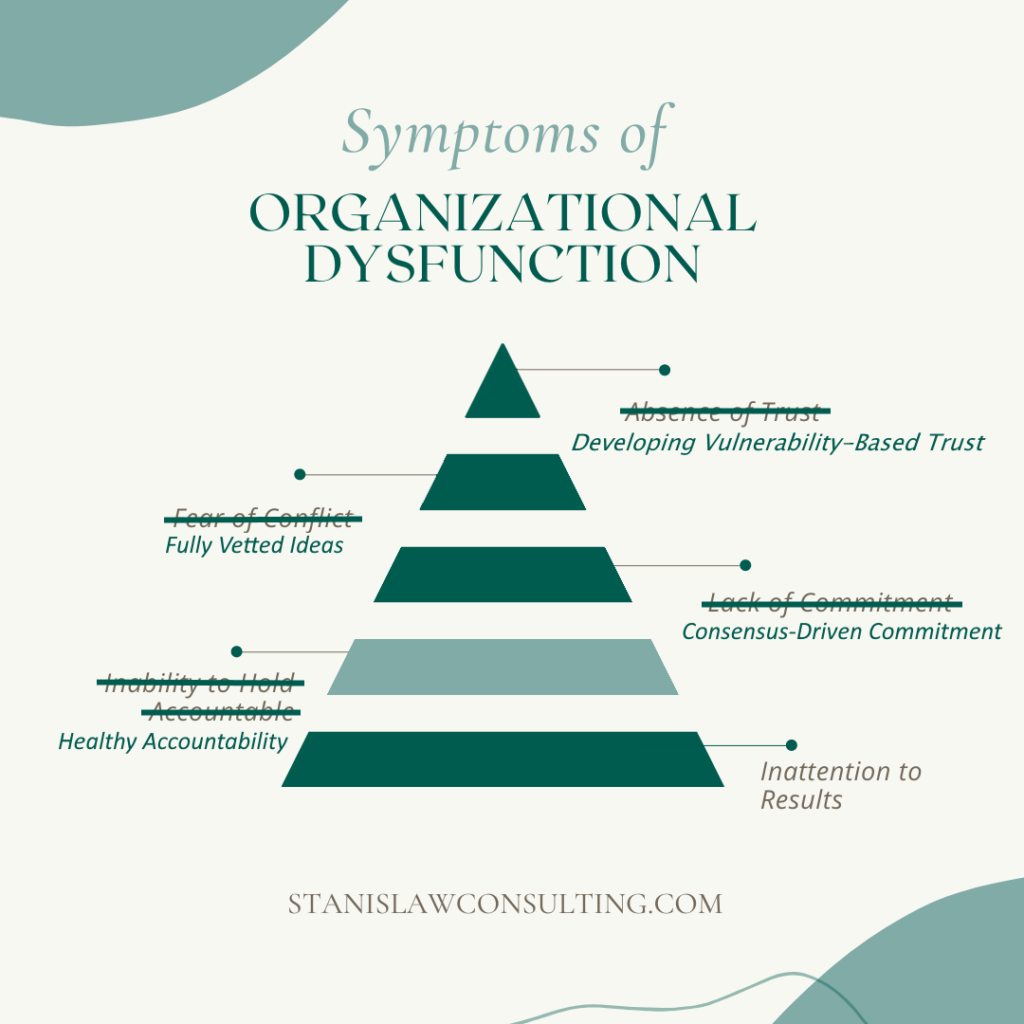All the planning in the world doesn’t assure that your team will meet its deadlines. When a coworker isn’t meeting the team’s expectations, the way the organization responds can be a telling symptom of organizational dysfunction. Find out how to avoid turning managers into disciplinarians by helping everyone on the team accept healthy accountability.
This is the fifth of a six-part blog series based on the book The Five Dysfunctions of a Team by Patrick Lencioni. Here are links to the previous posts:
- Part 1: 5 Symptoms of Organizational Disfunction,
- Part 2: Developing Team Trust
- Part 3: Overcoming Fear of Conflict
- Part 4: Getting Clarity on Commitment
The final blog posts will dive deeper into the last symptoms of organizational dysfunction and provide you with tools for treating the symptoms and moving your team toward added productivity.
Get Help with Leadership, Conflict Resolution, and Business Strategy
Talk to a consultant who can help you make strategic decisions about the future of your business.
What Happens When Things Go Wrong?
One way to assess the organizational health of your team is to look at what happens when things don’t go according to plan. When obstacles arise and the team falls short, the way your team responds can show whether everyone has bought in to the plan, or whether your employees are just going through the motions. Looking at how your teams come together – or doesn’t – when the work gets hard can be a good measure of the trust and commitment among team members.
Top-Down Accountability is a Sign of Organizational Dysfunction
In a dysfunctional organization, there is a fear of discipline from above. The idea that “when the cat’s away the mice will play” suggests that the only reason anyone is working toward the team’s goal is because someone higher up is holding them to task. But top-down accountability isn’t enough. When managers and supervisors become disciplinarians, it decreases productivity and work satisfaction for everyone involved. Managers don’t want to be the boogie men, and their team members don’t want to feel micromanaged or loomed over.

Healthy Accountability Comes from a Desire for Everyone to Be and Do Better
Instead, there must be peer pressure toward excellence. Peer-to-peer accountability demonstrates that your team isn’t just working together because they have to. They are striving to complete the goals they set out together using the plan they helped create. Commitment developed through cooperative goal-setting gives team members the courage to confront others when their behavior or performance isn’t measuring up.
Creating healthy accountability means making space for lateral, and even upward accountability. Teammates need to be given the authority and the space to call one another out. That includes the managers. You can encourage this by giving each team member an opportunity to host lightning-round status meetings. The host is tasked to ask about what went wrong, or what goals weren’t met, and what can be done better. This gives them permission to “speak truth to power,” creating a culture of supportive criticism and healthy accountability.
Get Help Developing Healthy Accountability to Overcome Organizational Dysfunction
Bringing everyone together to build commitment takes meaningful collaboration and a willingness to listen to coworkers’ concerns. You will need the help of a resourceful and emotionally intelligent facilitator to help you develop new patterns of peer-to-peer accountability. Once you and your coworkers are committed to your goals, you can take the final step to overcoming organizational dysfunction: focusing on team results.
David Stanislaw is an organizational development specialist with over 25 years’ experience in resolving organizational dysfunction. Through business consulting and facilitation, David helps businesses and teams improve productivity and team cohesion. Contact us to meet with David to move toward high organizational functioning today.


Recent Comments